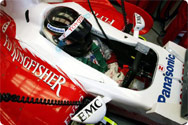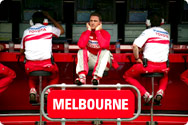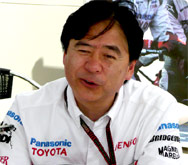Grand Prix > 2007 Grand Prix > Grand Prix of Australia > Review
|
|
21 March,2007 (Wed)
Thank you, as always, for your support. Noritoshi Arai, here, Director Technical Coordination at Panasonic Toyota Racing. The 2007 season has finally arrived. I hope we can count on your continued support throughout the year. Here is my report on the Australian Grand Prix held in Melbourne.
The final winter tests reveal a promising direction, and excitement heading into the opening race
This marks our sixth season in F1, since our first entry in 2002. We revealed the TF107 on January 12, and our goal is to make this the season that shows Panasonic Toyota Racing at the center spot on the podium. We completed two months of testing and development work leading up to the first race of the season.
Our initial test results weren't bad, and we even set top time at the joint session, but as winter progressed, we were hit with poor weather and some reliability issues that prevented us from moving through our program as planned. Accordingly, we weren't able to complete our setup work to adjust the car to the new tires being produced by Bridgestone, who will be the sole tire supplier this year. Going into the first race of the year, we found ourselves a little behind the other teams.
We conducted a private test session at Jerez, Spain, just prior to the Australian GP. Over the course of two trouble-free days, we were able to find a promising direction for our setup. The only issue is that Jerez and the Albert Park Circuit (site of the Australian GP) have quite different characteristics, and I was both concerned and excited to see how the TF107 would perform in the opening race.
Not quite enough testing on Friday, but a confirmation of direction for our setup

A sudden rain storm on the first day of the opening race. While this dampened the enthusiasm a bit, Panasonic Toyota Racing was able to go on and confirm car setups for the race in later sessions.
Melbourne was once again the scene of the season-opening race, after being bumped to later in the year last year due to scheduling conflicts. The weather was rainy, as forecast, and the morning session for the first day of the grand prix weekend started under wet conditions. This year, Friday free practice has been extended from 60 minutes to 90 minutes, but since new rules basically require each car to use two different types of tires, we needed to use Friday's free practice at Melbourne to thoroughly understand the characteristics of the medium and soft Bridgestone compounds we brought to the race in order to correctly set up our cars. Since the track surface was wet, we put wet tires on the cars during the morning session, and only ran an installation lap (confirming basic car functions).
Fortunately, the afternoon free practice brought dry conditions, so we were able to put on both types of tires going into the session. Unfortunately, part-way through the session one of the other team's cars went off the course, bringing out the red flag, and preventing us from completing our program. All in all, though, we were able to get a good sense of the behavior of the tires. As far as position, we were close to the back, with Jarno (Trulli) at 12th and Ralf (Schumacher) at 16th, but we were most concerned Friday with collecting a good amount of tire data, so our positions on the time chart were not very important to us.
Both cars qualify in top 10, clearing the minimum goal standard
 Jarno unveiled another new helmet design. While having no complaints about the performance of the TF107, Jarno finished just out of the points after a hard-fought battle.
Jarno unveiled another new helmet design. While having no complaints about the performance of the TF107, Jarno finished just out of the points after a hard-fought battle.Saturday morning's free practices started under rainy conditions again, leaving me with an ominous feeling. But fortunately, the rain quickly stopped, and both of our drivers were able to continue their setup work leading up to qualifying. The qualifying system in this year is basically the same "Knockout Qualifying" as used last year, with the exception that now two types of tires with differing characteristics can be used. Coming out of the practice session, we were able to identify performance differences in the two types of tires, so I was confident that we would be able to use both types effectively during the afternoon's official qualifying.
Honestly speaking, I was quite relieved that we were able to achieve our minimum goal of having both cars qualify in the top 10 at the first race of the season. The only negatives were, as you no doubt saw, the silly mistakes we committed during qualifying. One more mistake, and we may not have been able to get through to the final period. This is something we need to really tighten down if we want to be a winning team. Jarno's rear wing was damaged when we were unable to extricate the rear jack as he left the pits. We were able to change his wing for Sunday's race after petitioning the FIA. The cause of Ralf's slow-down during the second period was trouble with the gear box control system, but we were able to reset the system when he came in the pits. That resolved the problem, and we had no concerns going into Sunday's race.
Both cars complete the race, and Panasonic Toyota Racing wins one point. Dissatisfied by our race pace
 Ralf also had no complaints about the car. Ralf was able to finish 8th, despite fighting pneumatic system (air pressure used to move engine valves) problems during the last stint.
Ralf also had no complaints about the car. Ralf was able to finish 8th, despite fighting pneumatic system (air pressure used to move engine valves) problems during the last stint.
A great billow of smoke came out of the back of Jarno's car when the cars left for the formation lap before the race, but that was merely the burning of some excess oil in the combustion chamber, and since our telemetry indicated that there were no problems, we weren't concerned. However, Jarno did get off the line a bit slow, probably due to the fact that his grid position at 8th was on the inside-off the driving line. But Jarno was able to quickly regain position, and both he and Ralf battled for points position throughout the race, with Ralf ultimately securing a gratifying one point for our team.
New regulations this year require that each team use two types of tires during the race. We started both cars on the medium tires, planning to record stable lap times initially. We used mediums again at the first pit stop, strategizing to use the soft compound tire at the end of the race, after a certain level of rubber had built up on the track surface.

The Panasonic Toyota Racing cars, building up laps during the first and third stints of the race. Having qualified in the top 10, with both cars completing the race and a point won, Panasonic Toyota Racing was able to clear their "bare minimum" goals for the weekend. By no means satisfied, Panasonic Toyota Racing will continue to battle to the top for the F1 season crown.
Things went well as far as tire strategy, but we weren't happy with our race pace on either tire. While we showed top 10 speed during qualifying, during the race neither of our cars could make it into the top 10 fastest laps, leaving a bitter taste in our mouths. Since our winter testing consisted mainly of long runs, we knew we still had some issues to work out with respect to short run speed. But I was still disappointed, since I had thought we closed the gap in race pace with the top teams by at least a small amount. This isn't to say that the car has limited potential. Rather, I think it's the case that we weren't able to pull out all of the potential of the car during the weekend.
Having said that, it's a tremendous reward to have both cars complete the first race of the year. We plan on returning to the factory immediately to analyze our data and continue development testing.
Again, I thank you and ask for your continued support of Panasonic Toyota Racing.

Noritoshi Arai, looking forward to the season-opening Australian GP. Having both cars finish the first race of the season, the team looks for even better things at the next race in Malaysia.